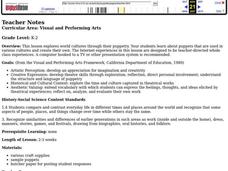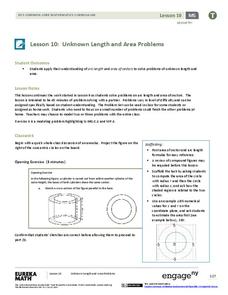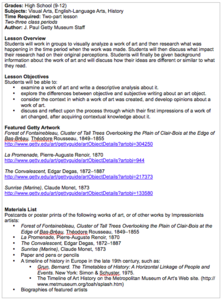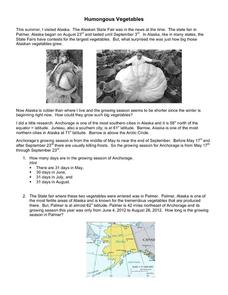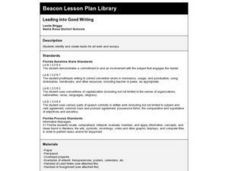Curated OER
2, 4, 6, 8 . . .What Do We Appreciate-Patterns, Patterns, Patterns
Students discover and predict patterns in a numerical sequence. Through the Internet and video segments, students begin with basic number patterns and extend their knowledge into higher math skills. They will also create new patterns...
Curated OER
2, 4, 6, 8 . . .What Do We Appreciate-Patterns, Patterns, Patterns
Students recognize patterns in a numerical sequence, create new patterns and predict outcomes to established sequences.
Curated OER
Oh Picasso!
Learners identify the painter Picasso as a famous Spanish cultural figure, name at least one of Picasso's painting styles and describe aspects of Picasso's Blue Period. They create their own Blue Period inspired work of art.
Curated OER
Teacher Lesson Plans: Africa
Learners explore Africa. In this cultural studies instructional activity, students go on safari, create African masks, or have an African party after they have researched the people, geography, and culture of the continent.
Curated OER
Modeling African American Scientist Ernest Just's Experiment on Parthenogenesis
A multicultural science lesson, students read a brief biography of Ernest Just and create a talk show in which they will perform an experiment after Just's work. With this lesson, students are taught to appreciate the contributions made...
Curated OER
Awesome authors (Elementary, Reading/Writing)
Fifth graders use technology to research and collect data. They develop awareness and appreciation of authors and genres. They organize information for presentation.
Curated OER
Newspaper Poems
Ninth graders appreciate the value of words, review the parts of speech, create original poetry, shape the poem, and write an explanation of the images he/she has created.
Curated OER
Native Americans
Students develop an appreciation of American Indians. They sing "Ten Little Indians," then act out "Brave Little Indian," an action story. They learn the poem "Then and Now."
Curated OER
PUPPETRY
Students explore world cultures through their puppetry. Your students explore puppets that are used in various cultures and create their own. The Internet experiences in this lesson are designed to be teacher-directed whole class...
Curated OER
Orchestrated Hell
Students evaluate a radio broadcast by correspondent Edward R. Murrow as a primary historic source. The broadcast, popularly known as "Orchestrated Hell" recounts Murrow's experiences with a Royal Air Force bomber crew on a raid over...
EngageNY
Estimating Probability Distributions Empirically 2
Develop probability distributions from simulations. Young mathematicians use simulations to collect data. They use the data to draw graphs of probability distributions for the random variable in question.
EngageNY
Unknown Length and Area Problems
What is an annulus? Pupils first learn about how to create an annulus, then consider how to find the area of such shapes. They then complete a problem set on arc length and areas of sectors.
EngageNY
Bean Counting
Why do I have to do bean counting if I'm not going to become an accountant? The 24th installment of a 35-part module has the class conducting experiments using beans to collect data. Learners use exponential functions to model this...
EngageNY
Buying a Car
Future car owners use geometric sums to calculate payments for a car loan in the 31st installment of a 35-part module. These same concepts provide the basis for calculating annuity payments.
Royal Shakespeare Company
RSC Activity Toolkit: The Merchant of Venice
Mercy! It's a wise teacher that knows their own students and what they need to appreciate Shakespeare's Merchant of Venice. A 28-page tool kit ensures that every scholar will play a part. The kit is divided into 20 sections, each of...
J. Paul Getty Trust
Historical Context: Discovering a Painting
Class members are presented with the image of a painting and asked to record their first impressions and analysis. They then research the time period in which it was painted and discuss how their research impacted their first impression...
Curated OER
Looking and Learning in the Art Museum
Have you just visited an art museum? Or can you create a gallery in your classroom to visit? Pupils create an original drawing that reinforces what was learned in a visit to the art museum. They will view original art work and verbally...
J. Paul Getty Trust
O Greek Shape! O Fair Pose!
Everything old is new again. The Los Angeles J. Paul Getty Museum presents a lesson on how Greek black-figure painting influenced eighteenth century Neoclassical artists. After looking at a series of examples, class members create their...
J. Paul Getty Trust
Shaping Ideas: Symbolism in Sculpture—Lesson 2
Young artists create a series of sketches of ideas for a sculpture, and using the criteria develop in the previous class, critique their sketches. They then choose one of their ideas and create their work of art.
Curated OER
Humongous Vegetables
Humongous vegetables can inspire and awaken your mathematicians to the large math concepts in our Common Core standards. What is the secret to growing such gargantuan garden objects in Alaska? In the state that is closest to the North...
National Geographic
Battery Lesson Plan
Not really just a lesson plan, but a series of activities, reading handouts, and teacher's guidelines for conducting a class mini unit on the battery. Physical scientists focus on the history of the cell battery, experiment with...
J. Paul Getty Trust
Expressing Emotions through Art Lesson 1—Everyone Shows They Care
In a instructional activity that explores art and emotions, scholars analyze a piece of art and discuss which emotions it portrays. They go on to reflect on their own emotions and how they are similar to the feelings expressed...
DocsTeach
Analyzing an Allegorical Statue
Everyone sees art differently. An informative resource focuses on the image analysis of an allegorical statue. Scholars study the photo of the statue and complete a worksheet based on their findings. To finish, academics participate in...
Curated OER
Leading into Good Writing
Discuss the importance of a lead in writing with your upper graders. They examine several examples of leads from literature and practice writing leads for pieces of artwork. They then select a topic from a list and write an introductory...
Other popular searches
- Teacher Appreciation Letter
- Teacher Appreciation Day
- Teacher Appreciation Card
- Teacher Appreciation Sample
- Teacher Appreciation Poetry
- Teacher Appreciation Week
- Teacher Appreciation Writing










